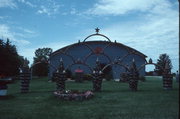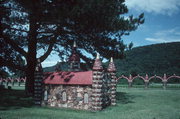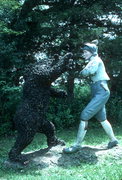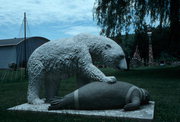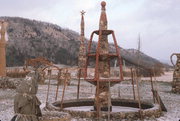Property Record
PRAIRIE MOON RD
Architecture and History Inventory
| Historic Name: | Prairie Moon Sculpture Garden & Museum |
|---|---|
| Other Name: | Prairie Moon (DNR) |
| Contributing: | |
| Reference Number: | 46632 |
| Location (Address): | PRAIRIE MOON RD |
|---|---|
| County: | Buffalo |
| City: | |
| Township/Village: | Milton |
| Unincorporated Community: | |
| Town: | 20 |
| Range: | 12 |
| Direction: | W |
| Section: | 36 |
| Quarter Section: | |
| Quarter/Quarter Section: |
| Year Built: | 1958 |
|---|---|
| Additions: | |
| Survey Date: | 1993 |
| Historic Use: | statue/sculpture |
| Architectural Style: | NA (unknown or not a building) |
| Structural System: | |
| Wall Material: | |
| Architect: | Herman A. Rusch |
| Other Buildings On Site: | Y |
| Demolished?: | No |
| Demolished Date: |
| National/State Register Listing Name: | Not listed |
|---|---|
| National Register Listing Date: | |
| State Register Listing Date: |
| Additional Information: | A 'site file' exists for this property. It contains additional information such as correspondence, newspaper clippings, or historical information. It is a public record and may be viewed in person at the State Historical Society, Division of Historic Preservation. Photo code #1: SOS! 30/20-25, 31/0-12 Down a quiet county road, halfway between Fountain City and Cochrane, curious travelers will discover this legacy of farmer, fiddler, and self-taught sculptor Herman Rusch. It began in 1952, when the sixty-six-year-old Rusch rented (and later purchased) the old Prairie Moon Dance Pavilion to display his collection of “natural wonders.” He had long loved and collected oddities of nature, and he filled his museum with unusual specimens of rock and wood, as well as souvenirs, antiques, photographs, tools, and other objects that held special significance for him. The sculpture garden started as a secondary endeavor in 1957, when Rusch built a rock-pile planter in front of the museum, hoping to lure passers-by. Over the next seventeen years, Rusch created an entire sculptural environment, covering two acres. He had seen other outdoor art gardens, including the Dickeyville Grotto; the Wisconsin Concrete Park; and the Grotto of the Redemption in West Bend, Iowa; and he kept these sources of inspiration in mind. On the flat lawn in front of his museum, he positioned forty-five sculptural objects, ranging in height from twelve inches to almost twenty feet. He used the malleable medium of concrete, which he dyed or painted, adding pebbles, mirrors, and pieces of broken pottery as the concrete began to set. A most memorable and spectacular piece is the 160-foot fence bounding the garden. At age seventy-nine, Rusch built this fence-sculpture in a single summer, setting it against the backdrop of the Mississippi River bluffs. The fence’s repeating arched forms are separated by rocket-like posts. Other pieces in the garden include several large dinosaurs, a watchtower, a “sun spire,” an enormous two-handled jug, a Hindu castle, a concrete mountain, and a self-¬portrait. Rusch also added several creations by his friend Halvor Landsverk, a sculptor from Minnesota: a polar bear and a seal, an Indian on horseback, an Indian maiden, and a man fighting a bear. Herman Rusch's Prairie Moon Museum is a grass roots arts environment owned and operated by the Town of Milton. It consists of nearly 40 colorful concrete, stone, and glass sculptures. See SOS! files at National Museum of American Art in Washington. D.C. for more information. IN 2013 THE SCULPTURE GARDEN AND WOOD FRAME BUILDING ARE IN GOOD CONDITION. |
|---|---|
| Bibliographic References: | Buildings of Wisconsin manuscript. |
| Wisconsin Architecture and History Inventory, State Historic Preservation Office, Wisconsin Historical Society, Madison, Wisconsin |

